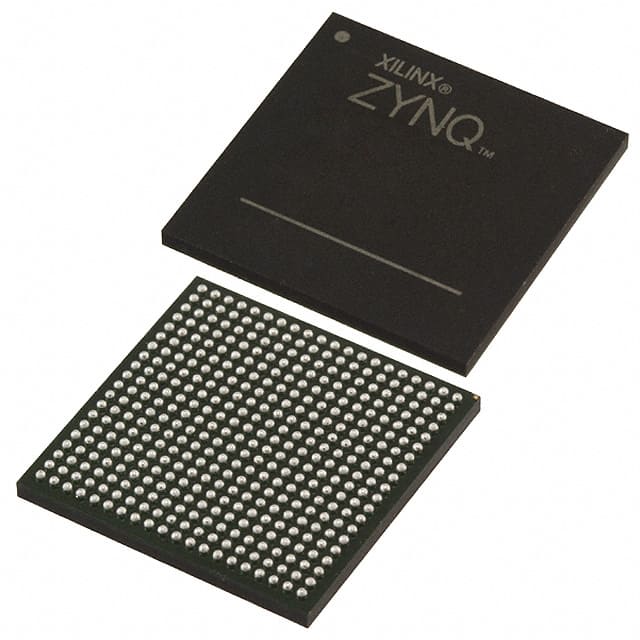XC7Z010-3CLG400E
Product Overview
Category
XC7Z010-3CLG400E belongs to the category of programmable System-on-Chip (SoC) devices.
Use
This product is commonly used in various electronic applications that require high-performance processing capabilities and flexibility.
Characteristics
- Programmable SoC with integrated processing system and programmable logic
- High-speed performance and low power consumption
- Advanced connectivity options
- Rich set of peripherals and interfaces
- Scalable architecture for customization
Package
XC7Z010-3CLG400E is available in a CLG400 package, which refers to a 400-ball chip-scale grid array package.
Essence
The essence of XC7Z010-3CLG400E lies in its ability to combine a processing system and programmable logic into a single device, providing a highly flexible and customizable solution for various applications.
Packaging/Quantity
XC7Z010-3CLG400E is typically packaged individually and is available in various quantities depending on the customer's requirements.
Specifications
- Processing System:
- Dual-core ARM Cortex-A9 processor
- Clock frequency: up to 800 MHz
- On-chip memory: up to 256 KB
- Programmable Logic:
- Logic cells: 28,000
- Look-Up Tables (LUTs): 17,600
- Flip-Flops: 35,200
- Block RAM: 270 KB
- Connectivity:
- Gigabit Ethernet
- USB 2.0
- UART
- SPI
- I2C
- CAN
- Operating Voltage: 1.0V
- Operating Temperature Range: -40°C to +100°C
Detailed Pin Configuration
The detailed pin configuration of XC7Z010-3CLG400E can be found in the product datasheet provided by the manufacturer.
Functional Features
XC7Z010-3CLG400E offers several functional features that make it a versatile and powerful SoC device: - High-performance processing system for running complex applications - Programmable logic for implementing custom functionality - Advanced connectivity options for seamless integration with other devices - Rich set of peripherals and interfaces for easy interfacing with external components - Scalable architecture allows customization to meet specific application requirements
Advantages and Disadvantages
Advantages
- Flexibility: The programmable nature of XC7Z010-3CLG400E allows for customization and adaptation to different application needs.
- Integration: Combining a processing system and programmable logic into a single device simplifies the overall system design and reduces component count.
- Performance: The high-speed processing capabilities of the ARM Cortex-A9 processor enable efficient execution of complex algorithms.
Disadvantages
- Complexity: Utilizing the full potential of XC7Z010-3CLG400E requires expertise in both software and hardware development.
- Cost: As a high-performance SoC, XC7Z010-3CLG400E may have a higher price compared to simpler microcontrollers or FPGAs.
Working Principles
XC7Z010-3CLG400E operates based on the principles of combining a processing system and programmable logic. The processing system executes software instructions, while the programmable logic provides the flexibility to implement custom hardware functionality. The two components work together to perform tasks efficiently and effectively.
Detailed Application Field Plans
XC7Z010-3CLG400E finds applications in various fields, including but not limited to: - Industrial automation - Robotics - Automotive electronics - Aerospace and defense systems - Medical devices - Communication infrastructure
In industrial automation, XC7Z010-3CLG400E can be used to control and monitor complex manufacturing processes. In robotics, it enables high-performance computation for autonomous navigation and manipulation tasks. In automotive electronics, it contributes to advanced driver assistance systems and in-vehicle infotainment. In aerospace and defense systems, it provides the necessary processing power for radar systems and avionics. In medical devices, it supports real-time data processing and analysis. In communication infrastructure, it facilitates high-speed data transmission and network management.
Detailed and Complete Alternative Models
Some alternative models to XC7Z010-3CLG400E that offer similar capabilities include: - XC7Z020-1CLG400C - XC7Z030-2CLG400I - XC7Z045-2FFG900E
These models differ in terms of their specifications, such as the number of logic cells, clock frequency, and available peripherals. The choice of an alternative model depends on the specific requirements of the application and the desired trade-offs between performance, cost, and power consumption.
In conclusion, XC7Z010-3CLG400E
Lista 10 Vanliga frågor och svar relaterade till tillämpningen av XC7Z010-3CLG400E i tekniska lösningar
Sure! Here are 10 common questions and answers related to the application of XC7Z010-3CLG400E in technical solutions:
Q: What is XC7Z010-3CLG400E? A: XC7Z010-3CLG400E is a System-on-Chip (SoC) device from Xilinx, which combines a dual-core ARM Cortex-A9 processor with programmable logic.
Q: What are the key features of XC7Z010-3CLG400E? A: The key features include a 28nm programmable logic fabric, 512KB on-chip memory, multiple high-speed I/O interfaces, and integrated peripherals.
Q: What are some typical applications of XC7Z010-3CLG400E? A: XC7Z010-3CLG400E is commonly used in applications such as industrial automation, automotive electronics, medical devices, and Internet of Things (IoT) solutions.
Q: How can I program XC7Z010-3CLG400E? A: XC7Z010-3CLG400E can be programmed using Xilinx's Vivado Design Suite, which provides a comprehensive development environment for FPGA and SoC designs.
Q: What programming languages can be used with XC7Z010-3CLG400E? A: XC7Z010-3CLG400E supports various programming languages, including VHDL and Verilog for hardware design, and C/C++ for software development running on the ARM Cortex-A9 cores.
Q: Can XC7Z010-3CLG400E interface with external devices? A: Yes, XC7Z010-3CLG400E offers a wide range of interfaces, such as UART, SPI, I2C, Ethernet, USB, and GPIOs, allowing it to communicate with external devices.
Q: What is the power consumption of XC7Z010-3CLG400E? A: The power consumption of XC7Z010-3CLG400E depends on the specific application and operating conditions. It is recommended to refer to the datasheet for detailed power specifications.
Q: Can XC7Z010-3CLG400E be used in safety-critical applications? A: Yes, XC7Z010-3CLG400E can be used in safety-critical applications. However, additional measures may need to be taken to ensure compliance with relevant safety standards.
Q: Are there any development boards available for XC7Z010-3CLG400E? A: Yes, Xilinx offers development boards like the Zynq-7000 SoC ZC702 Evaluation Kit, which includes XC7Z010-3CLG400E, allowing developers to prototype and evaluate their designs.
Q: Where can I find more information about XC7Z010-3CLG400E? A: You can find more information about XC7Z010-3CLG400E on Xilinx's official website, including datasheets, user guides, application notes, and technical support resources.
Please note that the answers provided here are general and may vary depending on the specific requirements and use cases.


